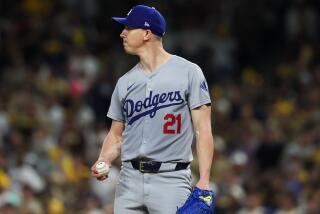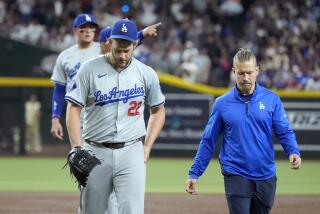âThrow-Inâ Has Been Throwing Very Well : Havens Finding Haven in Bullpen
The secret to Brad Havensâ best pitch is all in the delivery. He gives that casual shoulder shrug, head nod and a nervous sigh before focusing on his subject with serious expression.
Then comes the pitch, a changeup you donât get too often from relief pitchers.
âLuck; thatâs the only reason Iâve been pitching good,â Havens says. âIâve just been lucky.â
Acute humility prevents Havens from taking any credit for the surprising resurgence of his pitching career after being traded to the Dodgers by the Baltimore Orioles in May.
It is as if he believes that acknowledging his new-found success is the quickest way to lose it.
But there would seem to be more than luck involved. Havens, who calls himself the âthrow-inâ in the Tom Niedenfuer-for-John Shelby trade, has thrown well in recent weeks.
Before giving up a solo home run to Pittsburghâs John Cangelosi Sunday, Havens had allowed just 1 run and 8 hits in 18 previous innings spanning 13 appearances.
Going into tonightâs series opener with the St. Louis Cardinals at Dodger Stadium, Havensâ 2.43 earned-run average is the lowest among Dodger relievers. Although he does not have a save, Havens has allowed just 13 hits in 22 innings.
Suddenly, at 27, Havens has gone from journeyman pitcher, with a 21-32 record and 5.05 ERA in four previous seasons of bobbing between Triple-A and the major leagues, into a valued member of the Dodger bullpen.
How to explain?
âIâve got no idea,â Havens said.
Ron Perranoski, the Dodger pitching coach, says it is a combination of an effective curveball, a change of environment and an injection of confidence.
And, yeah, maybe a little luck, too.
âHe has a good arm,â Perranoski said. âHe can throw his fastball 90 (m.p.h.) and he has a good curveball. But the curveball is also his biggest problem when he doesnât throw it right.
âWe thought he could pitch like this. It was all a matter of up here.â
When Perranoski talks of âup here,â he is pointing to his head. Havensâ modesty often translates into a lack of confidence, as he confirms.
âItâs not my ability that has been holding me back all these years,â Havens said. âItâs upstairs. Itâs maturity. Iâm only 27, but Iâve been in (professional baseball) 10 years now. Maybe the maturing process is starting for me, I donât know.â
Perhaps Havens is skeptical about his most recent career advancement because he has shown promise before but wound up just struggling to stay on the major league roster.
Picked by the Angels in the eighth round of the 1977 draft, the 6-foot 1-inch left-hander was traded to the Minnesota Twins along with Ken Landreaux for Rod Carew in 1979.
Havens progressed swiftly through the minor leagues and was bought up to help the Twinsâ struggling staff as a starter at age 21. In parts of three seasons as a starter, Havens had an 18-28 record with a 4.94 ERA.
Midway through the 1983 season, though, Havens had an 8.18 ERA when he was shipped back to the minors. He was confined to Toledo until 1985, when the Orioles traded for him.
Last season, Havens finally made it to the majors for a full season as a reliever. He was 3-3, with a 4.56 ERA and a save. But this spring, Havens found himself back in the minors after a disastrous spring training, in which he gave up eight hits, five earned runs and two home runs in six innings.
Not knowing what to do with Havens in Rochester, N.Y, the Orioles Triple-A affiliate, management tried to reconvert him to a starter. He was struggling with a 6.03 ERA when he asked to go back to long relief.
His career at that point was a mess. Havens said his goal was to make the best of things in Rochester.
âI figured my best chance of getting back to the big leagues was as a reliever, not a starter,â he said. âSo, all I was doing was just trying to straighten myself out. I wasnât upset being at Rochester. I was having problems. Not physically, but mentally. I couldnât motivate myself. Things just didnât click.â
Havens said he didnât think the Orioles had given up on him, but they surely werenât counting on him for help this season, either.
But when the phone rang in his Rochester home May 22 and Havens was told he had been traded to the Dodgers, he was more than a little surprised that another team was interested.
âIt was about 11:30 in the morning,â Havens said. âI was watching âSesame Streetâ with my little girl when I got the call. I thought I was an Oriole for life. My first thought was, âHow do I get to Albuquerque from Rochester? But then they say they want me to join the Dodgers .
âTo think somebody wanted me is incredible. And a promotion is even more incredible, considering the way I was pitching at the time.â
But the way he is now pitching for the Dodgers has the club considering promoting Havens again, this time from middle relief to a starting job.
A conveniently scheduled day off Monday enabled the Dodgers to go with a four-man starting rotation and avoid choosing between Tim Leary or Havens as the fifth starter.
Even the possibility of becoming a starter, however, makes Havens uncomfortable. All the unassuming Havens would like to do in his relief role is slip in unnoticed, log a few uneventful innings and then quietly leave.
âI donât like starting because, mentally, the preparation for that was tough,â Havens said. âI over-prepared. I was so prepared that I had pitched nine innings in my mind before I even got out there. What I really should have done was come to the ballpark late.
âI like the bullpen because I donât know when Iâm going to pitch. What I try to do in the bullpen is not even think about the game. I get too involved, start thinking about every situation, every batter I might face. Thatâs when I screw up.â
More to Read
Go beyond the scoreboard
Get the latest on L.A.'s teams in the daily Sports Report newsletter.
You may occasionally receive promotional content from the Los Angeles Times.










